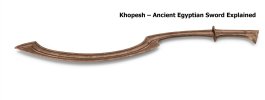Everest Forge
Dealer / Materials Provider
- Joined
- Oct 14, 2021
- Messages
- 59
Khopesh: The Ancient Egyptian Sword Explained
When we think of ancient Egypt, pyramids, pharaohs, and temples often come to mind. But behind the splendor of this great civilization was also a strong military tradition. Among the many weapons carried by Egyptian soldiers, one stands out for its unique look and reputation — the khopesh sword. With its curved, sickle-like blade, the khopesh was more than just a weapon. It was a symbol of power, authority, and Egyptian ingenuity.
Origins of the Khopesh
The khopesh first appeared around 2500 BCE, during Egypt’s Middle Kingdom, and quickly became one of the most recognized weapons of the Bronze Age. At first, it was made of bronze, but as technology advanced, iron versions were forged, giving warriors stronger and longer-lasting blades. Over time, it became the weapon of choice for both soldiers and pharaohs, representing not just strength in battle but also status and prestige.
Antique museum-collected khopesh sword (bronze original).
Symbolism in Egyptian Society
Egyptians viewed the khopesh as much more than a battlefield tool. It was a weapon tied to divine and royal power. Pharaohs and gods were often shown holding khopesh swords in carvings and temple art, reinforcing their authority. In burials, elite warriors and rulers were sometimes buried with a khopesh, showing its role as both a practical weapon and a sacred object.Unique Design and Features
The design of the khopesh is what makes it unforgettable. Its blade curves forward like a sickle, blending the features of both a sword and an axe. The outer edge was perfect for slashing attacks, while the inner curve could catch or pull away an enemy’s shield or weapon. Handles were made from wood or metal, often decorated for high-ranking warriors. This design gave the khopesh a balance of beauty and practicality that few weapons could match.
Two types of khopesh swords crafted by Everest Forge.
Tactical Use in Battle
On the battlefield, the khopesh gave Egyptian warriors a serious advantage. Its hooked design allowed soldiers to reach around shields and armor, making it particularly effective in close combat. It could disarm enemies, cut through defenses, and deliver powerful slashing blows. Because of its versatility, the khopesh became a favorite weapon for commanders and soldiers alike, a tool that could adapt to almost any combat situation.Other Ancient Egyptian Weapons
Although the khopesh became famous, it wasn’t the only weapon Egyptians relied on. Spears and polearms were crucial for large-scale battles, allowing soldiers to fight in tight formations. Daggers and short blades were used in close quarters or carried as backup weapons. Shields, usually made of wood and leather, protected soldiers from arrows and strikes. Some elite warriors also wore helmets and armor, though lighter protection was more common for mobility in battle.Influence Beyond Egypt
The impact of the khopesh didn’t stop at the borders of Egypt. Neighboring civilizations such as the Canaanites and Mesopotamians adopted and adapted the design, spreading its influence across the ancient world. Its distinct shape made it one of the most recognizable and imitated weapons of its time.The Khopesh Today
Even though thousands of years have passed, the khopesh continues to capture attention. Original examples are displayed in museums around the world, while high-quality replicas are sought after by collectors, history enthusiasts, and reenactors. Pop culture has also kept the khopesh alive — it appears in films, novels, and video games, where it often represents the mystery and power of ancient Egypt.View Our Khopesh Sword Collection
Browse hand-forged, functional khopesh swords inspired by ancient Egypt.View Collection
